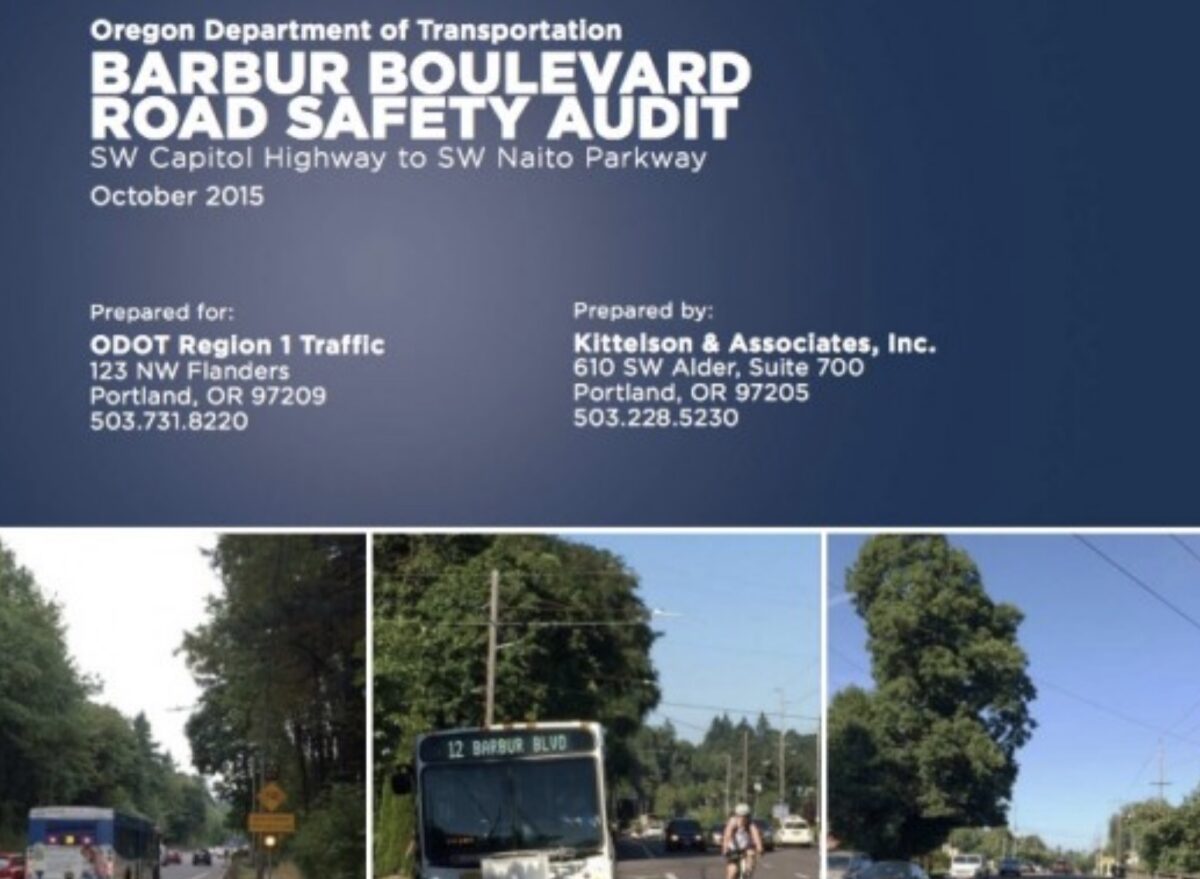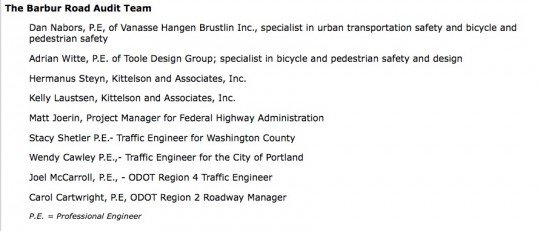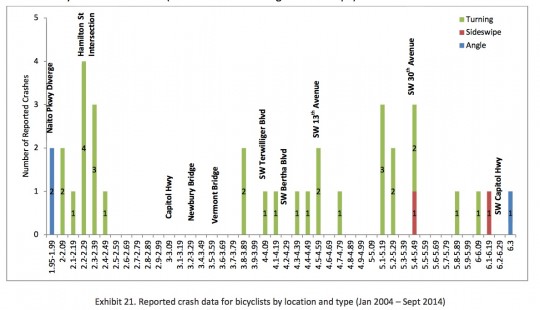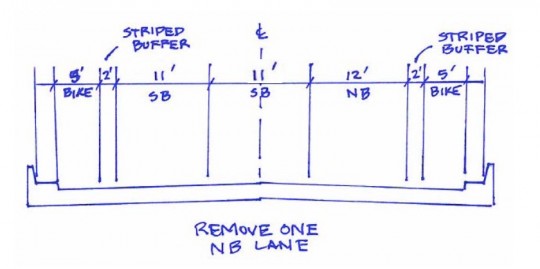The Oregon Department of Transportation has just released the Barbur Boulevard Safety Audit (PDF). The 115-page report takes an in-depth look at the safety issues of one the most deadly and dangerous urban highways in our region and it has been eagerly anticipated by advocates for months.
The audit came about after ODOT received significant pressure from the community (including a petition from the Bicycle Transportation Alliance) to do something about street’s dangerous bicycling conditions.
While the audit addresses many issues, the one that has generated most of the attention and controversy (and led to the audit in the first place) is the lack of a dedicated place to ride a bike across the Vermont and Newbury Bridges. Currently those bridges force road users into a pinch-point right at the location where ODOT’s own data shows has the highest speeds in the study area.
ODOT spent about five months on the project and had nine “independent” engineers from the public and private sector on the official Road Safety Audit team. That team spent 3-4 days in the field to observe how a 4.3 mile corridor of Barbur — from Naito Parkway to Capitol Hwy — is used by all modes. They biked, walked, and drove at all hours of the day.
Here’s the audit team roster:
The resulting report lists eight general safety issues, nineteen location-specific safety issues. The RSA team offers recommendations on how to address those issues in the short, near, and long-term. There are no cost estimates and the engineers did not go into detail about the technical feasibility of the various suggestions. Nor did they law out any timeline for completion. In a cover letter from the RSA Team leaders to Region 1 Manager Rian Windsheimer, says the report was intended to identify issues and “help the region plan.”
Why was an audit needed on Barbur? Here’s a snip from the report summarizing the toll it takes on our community:
Over the ten-year study period, 919 crashes were reported on Barbur Boulevard, including 873 vehicle related, 34 bicycle related, and 12 pedestrians. Ten fatalities were reported, eight of which involved alcohol.
The audit split up safety issues into three categories: I, II, and III, with III being the most severe. Speed and bicycle facilities were identified as two of the Category III issues.
On the issue of bicycle facilities, the audit provides a treasure trove of crash data. There have been 34 reported crashes involving people on bicycles in the past ten years. The majority of those crashes (26 of 34) happened because someone did not yield the right-of-way.
The chart below shows all the bicycle-involved crashes by location:
Here are the bicycle safety issues identified in the audit:
And here’s the audit’s breakdown near, short, and long-term suggestions to improve bicycling safety in general:
Near-term suggestions:
Provide clear direction for drivers and bicyclists through pavement markings at conflict areas, including:—At select locations, carrying bicycle lane markings through accesses/driveway area.
— Shortening skipped bicycle striping at transition/conflict areas to minimize weaving-section across bicycle lane.Intermediate suggestions:
Provide clear direction for drivers and bicyclists through pavement markings at conflict areas, including:
— Using green pavement marking at intersections and driveways with high volumes of right-turns.
— Eliminating on-street parking where possible.
— Extending skipped bicycle striping through wide intersections to guide bicyclists and bring attention to bicycles on the roadwayProvide consistent bicycle facilities by:
— Restriping the roadway to narrow travel lanes where possible (consistent with suggested corridor cross-section, see previous “Speed and Cross-section Inconsistency” section), including buffered bike lane.
Long-term suggestions to address bicycle facilities:
Create shared pedestrian and bicycle space where width is limited.Where there is insufficient roadway width, either widen the highway cross-section or provide alternative location to provide bicycle facilities.
The audit also has a section on pavement quality of bike lanes, which it identifies as a Category I safety issue.
As for the Vermont and Newbury Bridges, how best to provide “defined bicycle facilities” on them was the one issue in the entire report the audit team did not reach consensus on. They did however agree that the best option would be to replace and widen the existing structures.
Beyond a complete replacement of the bridges, the audit shares some suggestions on what can be done interim to make things safer.
In the near-term, the audit recommends two things: “adding pavement symbols indicating the loops that actuate the warning lights on the bridges so bicyclists are aware of where they need to ride”; and, “Consider signage or striping to encourage bicyclists to take the outside travel lane across the bridges.”
Advertisement
The audit also offers seven different options for how to manage the existing bridges; but they’re careful to underscore that they believe none of them are ideal:
“There is not a preferred option within the available existing cross section. The team suggests further evaluation of the trade-offs associated with these options and how they compare to the evolving vision for this corridor.”
One of the options they explore is to do the road diet and re-allocate space so that the existing cross-section over the bridges has three standard lanes and a bicycle-only lane instead of four standard lanes and no space for bicycling. This is the design the BTA and other advocates are pushing for. PBOT studied this design and found it would cut speeds significantly and result in only minimal delays to users during peak times.
Here’s the sample cross-section:
And here are the “cons” with this option noted by the audit team:
— The ability to implement incident management (ICM) is limited with a single northbound travel lane, because northbound I-5 traffic may be redirected to the I-5 Terwilliger exit to bypass an incident to the north on I-5.
— Potential safety implications associated with the transition area at the two-to-one lane merge and the potential impact it may have on upstream signals.
— Increased congestion for northbound traffic anticipated, with impacts to upstream signals (SW Miles Street, SW Terwilliger Boulevard, SW Bertha Boulevard), which may result in increased rear-end crashes.
— Although Barbur Boulevard serves directional peak traffic (AM northbound into town and PM southbound out of town), there is a northbound PM peak in addition to the AM peak because of congestion on I-5 – motorists use Barbur Boulevard as an alternate to access the Ross Island Bridge). Therefore, this option has impacts during both the AM and PM peak periods.
There’s a lot to digest in this audit. Will it help increase urgency on ODOT to make Barbur safer for cycling? That depends on how it’s used by our electeds, agency leaders, and advocates. From ODOT’s perspective, they say the recommendations will be “taken into account” as funding becomes available and as they plan future projects. They also include this friendly reminder in the report: “Safety issues cannot be completely addressed through engineering alone.”
Stay tuned as we continue to cover Barbur Blvd.
Download the full report here.
— Jonathan Maus
jonathan@bikeportland.org
(503) 706-8804
@BikePortland







